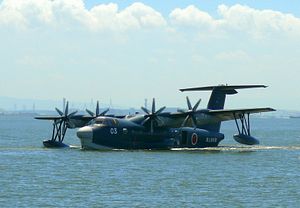As Japanese Prime Minister Shinzo Abe arrives in India, there are rumors once again that this visit will be the one to see the conclusion of a long-pending defense deal between India and Japan.
According to local Indian reports, the presumptive deal that may be announced will include a 10-to-15 percent discount on the per-unit cost of each ShinMaywa US-2i amphibious aircraft, coming in at a total value of around $1.3 billion.
India would purchase 12 of the aircraft off-the-shelf and may produce up to 18 more domestically, in line with Indian Prime Minister Narendra Modi’s “Make in India” initiative.
The deal would represent Japan’s largest overseas defense deal since it lifted its decades-long self-imposed ban on defense exports in 2014. It would additionally represent an important milestone in the India-Japan strategic relationship.
Since 2014, despite political sanction at the highest levels in both countries, negotiations had been bogged down over New Delhi’s concerns regarding the per-unit price and questions regarding potential technology transfer and domestic manufacturing in India.
For India, the short-take-off-capable ShinMaywa US-2 would add an important search-and-rescue capability in the Indian Ocean region. India may base the aircraft at the Andaman and Nicobar Island in the Bay of Bengal among other sites; the 4,500 km range of the aircraft would allow the US-2 aircraft to support civilian and naval vessels alike deep in the Indian Ocean.
On Monday, the Hindu‘s Business Line reported that during Indian Defense Minister Arun Jaitley’s recent visit to Japan on September 5 and 6, the final questions surrounding pricing were settled.
Jaitley met with his counterpart Itsunori Onodera, who returned to the Japanese defense portfolio in August following a cabinet reshuffle.
Onodera had presided over earlier negotiations as well on the deal, which dates back to before Abe’s administration, to the Democratic Party of Japan governments of Prime Ministers Yoshihiko Noda and Naoto Kan.
According to the Hindu, the deal will be announced during Abe’s visit to India, where he will confer with Modi on a range of issues of bilateral, regional, and global importance.
Since India and Japan set up their Strategic and Global Partnership in 2006, they have had annual rotating prime ministerial meetings; the arrangement is the only reciprocal arrangement of its kind for either country at the head-of-government level.
Defense ties between India and Japan have steadily expanded since the mid-2000s. The two countries began holding bilateral military exercises in 2012 and Japan now is a regular participant in the formerly bilateral U.S.-India Malabar drills.
This year’s exercise in the Indian Ocean involved a major focus on anti-submarine warfare. Japan’s first Izumo-class helicopter destroyer, the largest class of vessel in service with the Japanese Maritime Self-Defense Force, participated alongside India’s INS Vikramaditya aircraft carrier.
In addition to the conclusion of the long-pending US-2 deal, there are other prospects for Japan-India defense commercial cooperation.
Earlier this summer, Japan’s Mitsubishi-Kawasaki consortium received a Request For Information (RFI) from the Indian Navy for an $8 billion advanced air-independent propulsion (AIP) attack submarine contract.

































